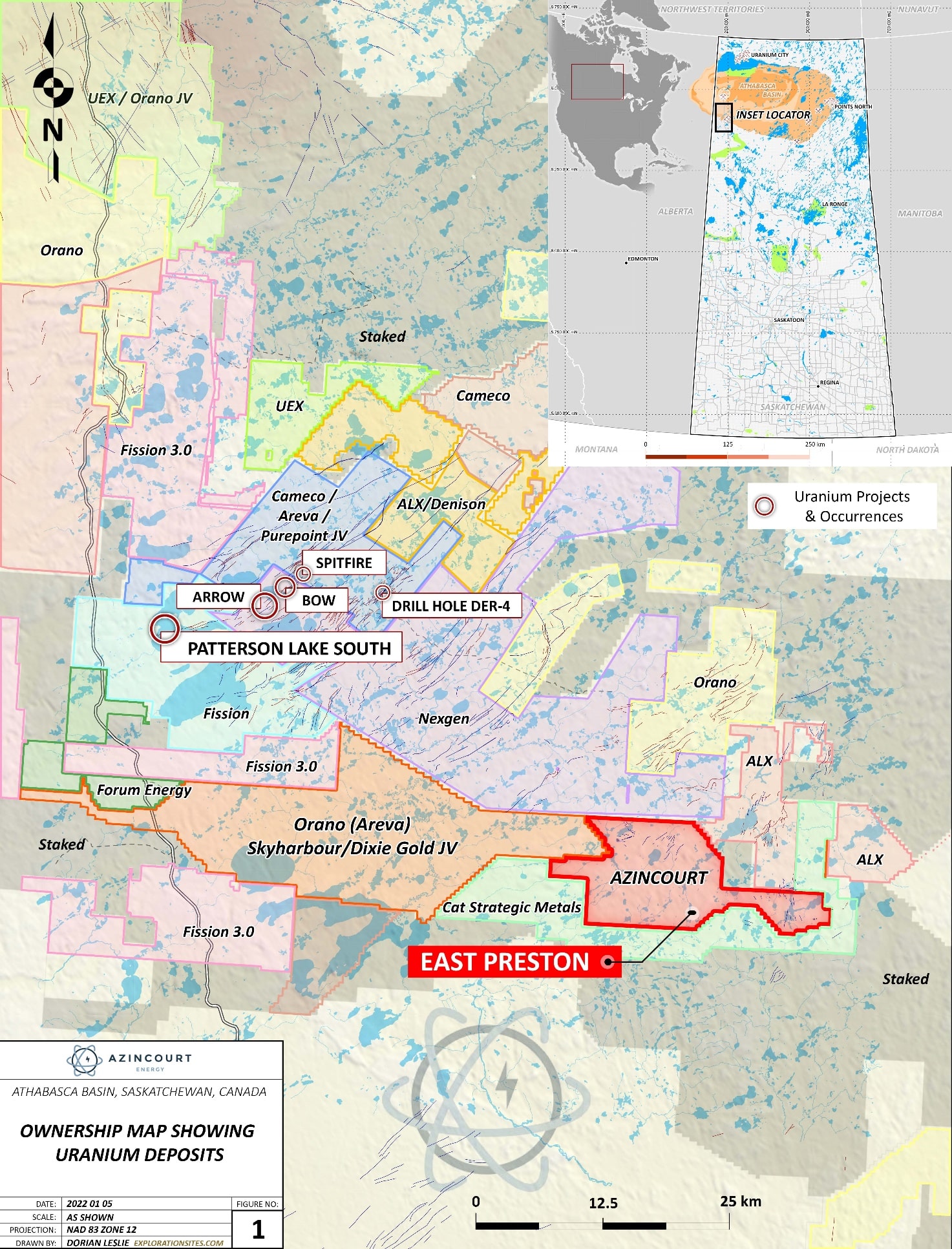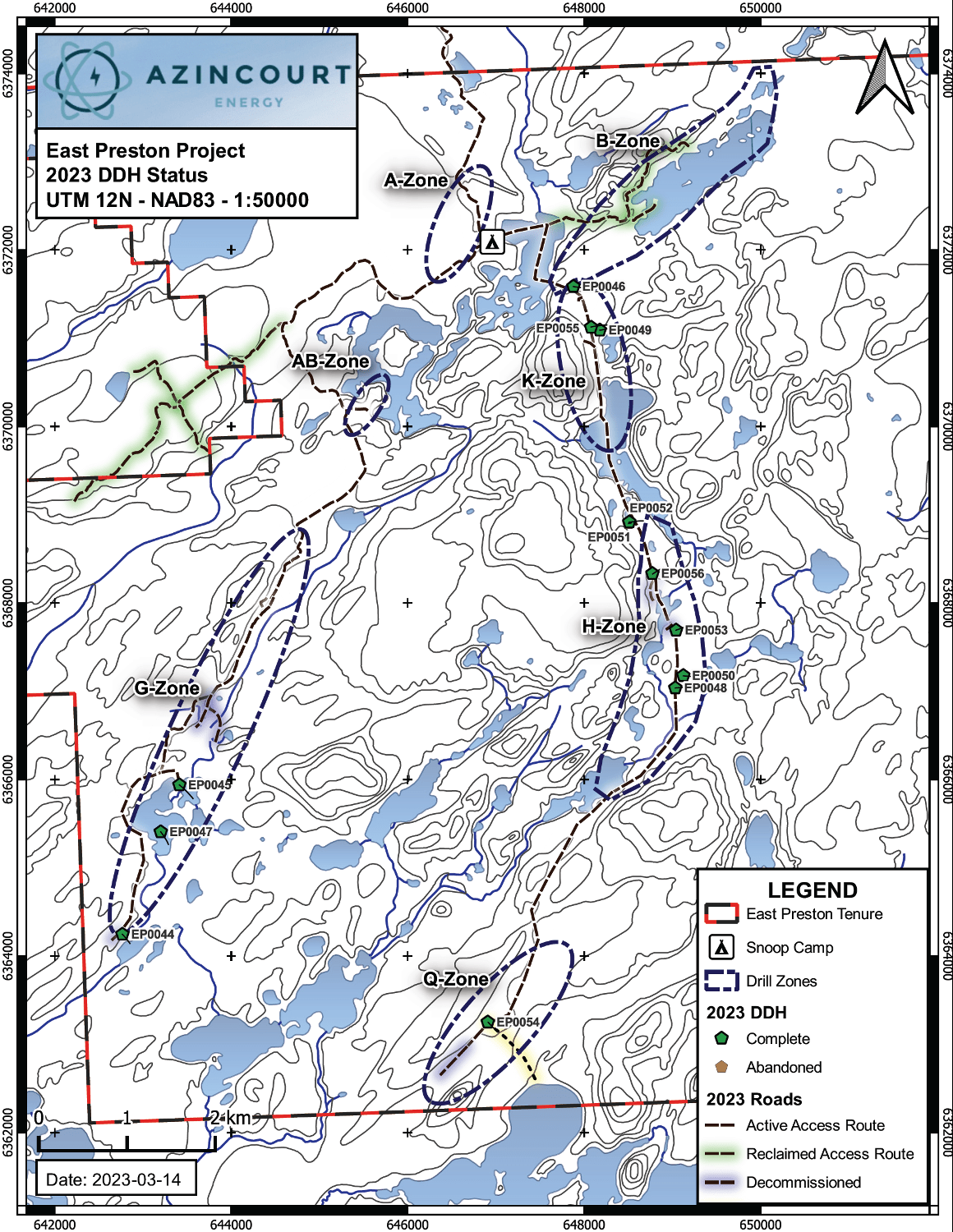- 3,066 m completed in 13 drill holes
- Dravite clay alteration identified in K and H-Zones
- Over 600 samples sent for analysis
VANCOUVER, British Columbia, March 28, 2023 (GLOBE NEWSWIRE) -- AZINCOURT ENERGY CORP. (“Azincourt” or the “Company”) (TSX.V: AAZ, OTCQB: AZURF), is pleased to announce that the 2023 exploration program has been completed at the East Preston uranium project in the Athabasca Basin, Saskatchewan, Canada.
Drilling for the 2023 program at the East Preston Project commenced on February 2nd and was complete on March 8th. In total 3,066 metres has been completed in 13 drill holes. After some initial startup delays due to extreme weather variations, two drill rigs were able to complete 12 drill holes and one abandoned due to drilling difficulties. Drilling was focused on the G, K, H, and Q zones with prior progress reported in a news release dated February 28th, 2023. Demobilization of the drill equipment is complete, and the teardown of the camp is underway. Decommissioning of the road is expected to be complete by the first week in April.
Winter 2023 Diamond Drilling Program
The winter 2023 drill program was executed by TerraLogic Exploration Inc. under the guidance and supervision of Azincourt’s Vice President, Exploration, Trevor Perkins, P.Geo, and Jarrod Brown, M.Sc., P.Geo, Chief Geologist and Project Manager with TerraLogic Exploration. Field activities were supervised by Laura Tennent, B.Sc., Geologist and Project Manager with TerraLogic Exploration. Increased program costs associated with road construction, fuel, supplies, and weather led to an overall reduction in planned meterage and the Joint Venture partners increasing the program budget to facilitate getting as much information as possible this field season. The priority of the drill program was to continue to evaluate the alteration zones and elevated uranium identified in the winter of 2022 with a focus on the G, K, H and Q Zones (Figure 3).
Drilling on the northeast trending G-Zone (Figure 3) consisted of three holes to follow up 2022 results. Extensive hydrothermal alteration and evidence of east-west cross-cutting structures have been intersected along the southern portion of the zone. The alteration zone is highlighted with intervals of hydrothermal hematite alteration and extensive evidence for a steep east-west fault cross-cutting the main northeast trending structure and graphitic lithologies. Elevated radioactivity was intersected in EP0045 and EP0047.
On the north end of the K-Zone (Figure 3), three holes were completed. Drilling has intersected extensive structure and hydrothermal alteration, increasing the length of this alteration zone by 300 meters to 1500 meters long. Extensive clay alteration within the structural zone is an indication of upgraded prospectivity and vectoring towards potential mineralization. Samples of clay alteration were analyzed by Short Wavelength Infrared Reflectance (SWIR, sometimes referred to as “PIMA”) to confirm the clay species. All three holes contained illite and kaolinite clay species, with EP0049 also having dravite identified within the structural zone.
Illite and kaolinite are both indicators of hydrothermal alteration typically found within alteration halos of unconformity uranium deposits. Dravite is a boron-rich clay which is typically found within a larger clay package in close proximity to uranium mineralization in the system. Both illite and dravite have been identified as being significant vectors for the recent Patterson Lake North discovery by F3 Uranium approximately 60 km to the northwest of the East Preston project.
The H-Zone covers a change in orientation of the structural and conductive trend from north south to southwest trending (Figure 3). Five holes have been completed on the north section of the H Zone. Drilling intersected an intense graphitic fault zone with hydrothermal alteration. The Illite clay alteration halo identified in the K-Zone extends south into the H Zone as far as EP0053. Hole EP0053 intersected elevated radioactivity and both kaolinite and dravite are also present within the illite alteration package. Dravite was also identified in hole EP0052.
One drill hole was completed on the Q-Zone. Weak structures with hematite alteration were identified with a notable lack of a graphitic package. Additional drilling will be warranted to confirm the source of the conductor; however, this area will be a lower priority moving forward.
A total of 687 samples were collected throughout the program and sent to the Geoanalytical Laboratory at the Saskatchewan Research Council in Saskatoon, Saskatchewan for analysis. Results are expected to start arriving in May.
The company considers the drilling results to date to be significant, as major uranium discoveries in the Athabasca Basin such as McArthur River, Key Lake, and Millennium were primarily the result of drill testing of strong alteration zones related to conductor features. Identifying and upgrading the strong alteration zones is a significant step forward in identifying the key areas along the conductor trends where more attention is required.
“The alteration we are seeing in the K and H Zones is very encouraging” said VP, Exploration, Trevor Perkins. “This and previous programs have shown that we have a significant alteration system present on the property. Finding the extents of this system and identifying where within that system the alteration fluids are focusing remains a top priority. The identification of dravite and illite clays emphasizes that we are on the right track and getting very close,” continued Mr. Perkins.
“We’re very pleased with the results of this year’s program so far,” said president and CEO, Alex Klenman. “Intersecting dravite and other clays, after the discovery of hematite alteration last winter, matches the very exploration model we’re following. This is what we wanted to see and needed to see. This is a very positive development and we’re excited to see the lab results.
“As for meters drilled, which ended up being less than what we set out to achieve, we entered this drill program with a budget for 5000 meters or more. Unfortunately, inflationary costs are now impacting every aspect of field work. Everything was more expensive this year compared to previous drill programs. Budget wise we were on par with last winter’s program, however the increase in costs across the board ultimately reduced the overall meterage. Nevertheless, we’re happy with the progress we’re making and very eager to get more holes in the ground, particularly in and around the newly discovered clay alteration zones. We’re looking into potential summer work and will update stakeholders accordingly as we progress the initiative,” continued Mr. Klenman.
East Preston Targets
The primary target area on the East Preston Project is the conductive corridors from the A-Zone through to the G-Zone (A-G Trend) and the K-Zone through to the H and Q-Zones (K-H-Q Trend) (Figure 2). The selection of these trends is based on a compilation of results from the 2018 through 2020 ground-based EM and gravity surveys, property wide VTEM and magnetic surveys, and the 2019 through 2022 drill programs, the 2020 HLEM survey indicates multiple prospective conductors and structural complexity along these corridors.
Drilling has confirmed that identified geophysical conductors comprise structurally disrupted zones that are host to accumulations of graphite, sulphides, and carbonates. Hydrothermal alteration, anomalous radioactivity, and elevated uranium have been demonstrated to exist within these structurally disrupted conductor zones.
Community Engagement
Azincourt Energy continues to be engaged in regular meetings with the Clearwater River Dene Nation and other rights holders to ensure that concerns of the local communities are addressed with regards to the East Preston project. Azincourt looks forward to a continued close working relationship with CRDN and other rights holders to ensure that any potential impacts and concerns are addressed and that the communities can benefit from activities in the area through support of local business, employment opportunities, and sponsorship of select community programs and initiatives. Local businesses are engaged to provide services and supplies and members of the Clearwater River Dene Nation and surrounding communities have been directly employed on site or to provide support and services to keep the camp and programs running.
Figure 1: East Preston Project Location – Western Athabasca Basin, Saskatchewan, Canada
Figure 2: 2023 Target areas and Drill Hole Locations at the East Preston Uranium Project
About East Preston
Azincourt controls a majority 78.4% interest in the 25,000+ hectare East Preston project as part of a joint venture agreement with Skyharbour Resources (TSX.V: SYH), and Dixie Gold. Three prospective conductive, low magnetic signature corridors have been discovered on the property. The three distinct corridors have a total strike length of over 25 km, each with multiple EM conductor trends identified. Ground prospecting and sampling work completed to date has identified outcrop, soil, biogeochemical and radon anomalies, which are key pathfinder elements for unconformity uranium deposit discovery.
The East Preston Project has multiple long linear conductors with flexural changes in orientation and offset breaks in the vicinity of interpreted fault lineaments – classic targets for basement-hosted unconformity uranium deposits. These are not just simple basement conductors; they are clearly upgraded/enhanced prospectively targets because of the structural complexity.
The targets are basement-hosted unconformity related uranium deposits similar to NexGen’s Arrow deposit and Cameco’s Eagle Point mine. East Preston is near the southern edge of the western Athabasca Basin, where targets are in a near surface environment without Athabasca sandstone cover – therefore they are relatively shallow targets but can have great depth extent when discovered. The project ground is located along a parallel conductive trend between the PLS-Arrow trend and Cameco’s Centennial deposit (Virgin River-Dufferin Lake trend).
Qualified Person
The technical information in this news release has been prepared in accordance with the Canadian regulatory requirements set out in National Instrument 43-101 and reviewed on behalf of the company by C. Trevor Perkins, P.Geo., Vice President, Exploration of Azincourt Energy, and a Qualified Person as defined by National Instrument 43-101.
About Azincourt Energy Corp.
Azincourt Energy is a Canadian-based resource company specializing in the strategic acquisition, exploration, and development of alternative energy/fuel projects, including uranium, lithium, and other critical clean energy elements. The Company is currently active at its joint venture East Preston uranium project in the Athabasca Basin, Saskatchewan, Canada, and the Escalera Group uranium-lithium project located on the Picotani Plateau in southeastern Peru.
ON BEHALF OF THE BOARD OF AZINCOURT ENERGY CORP.
“Alex Klenman”
Alex Klenman, President & CEO
Neither the TSX Venture Exchange nor its regulation services provider (as that term is defined in the policies of the TSX Venture Exchange) accepts responsibility for the adequacy or accuracy of this release.
This press release includes “forward-looking statements”, including forecasts, estimates, expectations and objectives for future operations that are subject to a number of assumptions, risks and uncertainties, many of which are beyond the control of Azincourt. Investors are cautioned that any such statements are not guarantees of future performance and that actual results or developments may differ materially from those projected in the forward-looking statements. Such forward-looking information represents management’s best judgment based on information currently available. No forward-looking statement can be guaranteed, and actual future results may vary materially.
For further information please contact:
Alex Klenman, President & CEO
Tel: 604-638-8063
Azincourt Energy Corp.
1430 – 800 West Pender Street
Vancouver, BC V6C 2V6
www.azincourtenergy.com
Photos accompanying this announcement are available at:
https://www.globenewswire.com/NewsRoom/AttachmentNg/89ea4063-78dc-483b-aff4-40aa5675301e
https://www.globenewswire.com/NewsRoom/AttachmentNg/533225bf-54c4-4cb8-bf7b-cdee0b4ac629







